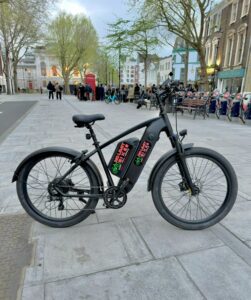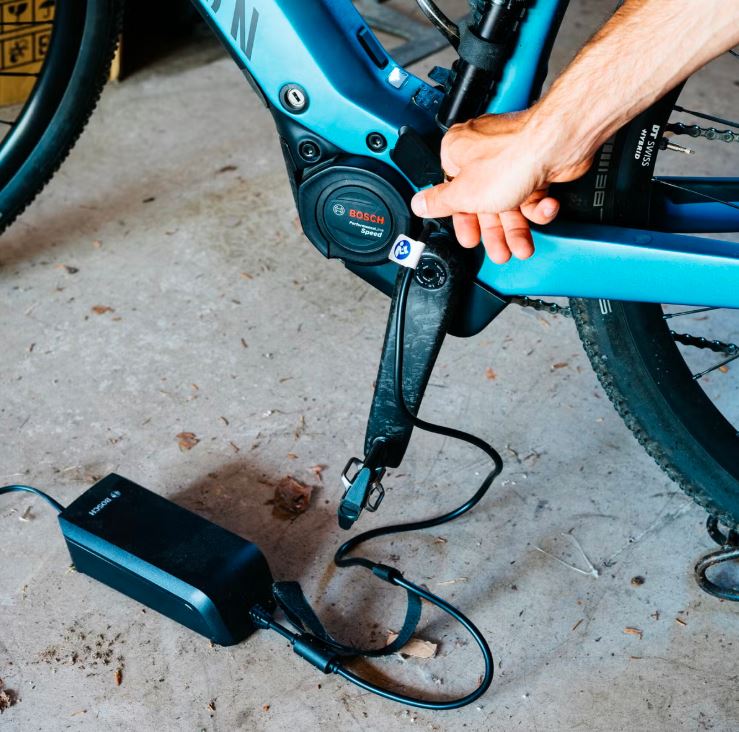Powering Your Ride Efficiently
The electric bike (e-bike) market is booming, with global sales projected to hit 40 million units in 2025, driven by urban commuters and adventure enthusiasts seeking eco-friendly mobility. E-bikes, with motors up to 750 watts and ranges of 50–93 miles, rely heavily on their lithium-ion batteries, which require efficient, safe charging to minimize downtime. E-bike battery chargers for fast charging in 2025 are transforming the riding experience by slashing charge times from 4–6 hours to as little as 1–3 hours, ensuring riders stay on the move. This article explores the top e-bike battery chargers for fast charging in 2025, covering features, compatibility, safety, and top models to keep your e-bike powered for urban commutes or rugged adventures.
The Importance of Fast Charging for E-Bike Riders
Fast charging is a game-changer for e-bike users, particularly the 82% of riders commuting in urban areas where time is critical. Traditional chargers (2–3A) take 4–6 hours to fully charge a 10–20Ah battery, while e-bike battery chargers for fast charging in 2025 deliver 5–10A outputs, reducing charge times to 1–3 hours. This efficiency is vital for daily commuters, delivery riders, and travelers needing quick top-ups, but it must be balanced with battery health, as frequent fast charging can reduce lifespan by up to 20% if not managed properly.

Why Fast Charging Matters
Fast charging minimizes downtime, allowing riders to recharge during short breaks, such as at a café or office. For example, a 5A charger can charge a 48V 15Ah battery to 80% in about 2 hours, compared to 5 hours with a standard 2A charger. E-bike battery chargers for fast charging in 2025 also support the growing e-bike market, with a 10.6% CAGR in the 18–30 age group, who prioritize convenience and performance. These chargers enhance flexibility, enabling riders to cover longer distances without range anxiety, saving 225 kg CO₂ annually compared to car use.
Risks and Considerations
While fast charging boosts efficiency, it generates more heat, potentially accelerating battery degradation by 10–20% over a year of regular use. Using incompatible chargers risks damage or fires, with 15% of home electrical fires linked to uncertified devices. E-bike battery chargers for fast charging in 2025 must include safety features like overcharge protection and temperature control to mitigate these risks, ensuring compliance with UL 2849 standards for e-bike batteries.
Key Features of E-Bike Battery Chargers for Fast Charging
Selecting the best e-bike battery chargers for fast charging in 2025 requires focusing on compatibility, speed, safety, and portability. Here are the essential features to prioritize:
Voltage and Connector Compatibility
Chargers must match the e-bike’s battery voltage (e.g., 36V, 48V, 52V) and connector type (e.g., XLR, DC 5.5×2.1mm, ST3). Using an incompatible charger can damage the battery or reduce its lifespan by 35%. For example, a 54.6V charger is ideal for 48V lithium-ion batteries, ensuring efficient charging without overloading. Universal chargers, like those from Quartet Electronics, support multiple voltages and plug types for versatility.
High Amperage for Fast Charging
Amperage determines charging speed. Standard chargers (2–3A) suit overnight charging, while fast chargers (5–10A) deliver quick top-ups. A 5A charger, like eBikeling’s, charges a 48V battery in 2–3 hours, compared to 6 hours with a 2A model. Higher amperage generates heat, so chargers should include cooling fans or CCCV (Constant Current, Constant Voltage) technology to protect battery health.
Safety Features
Safety is critical, given the 267 lithium-ion battery fires reported in NYC in 2023. E-bike battery chargers for fast charging in 2025 should feature:
-
Overcharge Protection: Automatically stops charging when the battery is full, preventing overheating.
-
Short-Circuit Prevention: Protects against electrical faults, reducing fire risks.
-
Temperature Control: Monitors heat to avoid damage, as overheating precedes 70% of charging-related incidents.
-
UL Certification: Ensures compliance with safety standards, mandatory in cities like New York.
Portability and Durability
For commuters and travelers, compact, lightweight chargers (under 1.3 lbs) are ideal. Bosch’s 600-gram charger, 40% smaller than its 4A model, is perfect for on-the-go charging. Durable, IP67-rated designs withstand humid or rainy conditions, ensuring reliability for urban riders.
Smart Charging Technology
Smart chargers, like the Nitecore UNK2, use microprocessors to optimize charging based on battery condition, extending lifespan by up to 35%. Features like automatic shut-off and real-time diagnostics via apps enhance user control, making them ideal for tech-savvy riders.
Top E-Bike Battery Chargers for Fast Charging in 2025
Below are the best e-bike battery chargers for fast charging in 2025, selected for performance, safety, and compatibility.
eBikeling 5A Fast Charger: Best for High-Demand Riders
The eBikeling 5A Charger for 48V lithium-ion batteries delivers rapid charging in 2–3 hours, with a 5.5×2.1mm connector for broad compatibility. Its LED indicator (red for charging, green for full) simplifies monitoring, and built-in overcharge protection ensures safety. Priced at $50, it’s ideal for commuters needing quick turnarounds, though older batteries may take longer (up to 6 hours). Free shipping on orders over $50 makes it cost-effective. Explore eBikeling’s fast chargers.
Nitecore UNK2 Smart Charger: Best for Advanced Features
The Nitecore UNK2 offers a 5A output with intelligent charging algorithms, adapting to battery conditions to maximize lifespan. Compatible with 36V–52V batteries, it includes over-voltage, over-current, and temperature protection. Priced at $80, its premium features suit tech enthusiasts, though its higher cost may deter budget-conscious riders. Its compact design (under 1 lb) is perfect for travel.
Bosch 6A Fast Charger: Best for Performance E-Bikes
Bosch’s 6A charger, designed for high-capacity batteries (500–750Wh), charges to 50% in 1 hour and fully in 2–3 hours. Weighing less than 1.3 lbs, it’s 40% more compact than standard models, with CCCV technology and IP67 waterproofing. Priced at $120, it’s ideal for frequent riders of Bosch-powered e-bikes, like those from Trek or Specialized. Discover Bosch’s charging solutions.
Vannel 10A Lithium Charger: Best for High-Power Needs
Vannel’s 10A charger supports 24V–29.4V batteries, delivering fast charging in 1–2 hours for 10–15Ah batteries. With dual voltage options and robust safety features (over-voltage, short-circuit protection), it’s suited for cargo or performance e-bikes. Its compact design ($60) ensures portability, though it requires careful voltage matching to avoid damage.
Electric Bike Company Smart Super Charger: Best for Premium Models
Designed for EBC’s 48V–52V systems, this 3.5A charger uses CCCV technology and cooling fans for efficient, safe charging in 2–4 hours. Priced at $100, it includes dual fuse safety and is ideal for premium e-bikes like the EBC Model A. Its durable build suits urban commuters, though it’s specific to EBC models.
How to Choose the Right E-Bike Battery Charger
Selecting the best e-bike battery chargers for fast charging in 2025 depends on your riding habits, battery type, and budget. Here’s how to choose:
Verify Compatibility
Check your e-bike’s battery voltage (36V, 48V, 52V) and connector type (XLR, DC barrel, ST3). For example, Lectric’s 1-pin charger is specific to XP models, while eBikeling’s 5.5×2.1mm fits most 48V batteries. Using an incompatible charger risks battery damage or fire hazards.
Balance Speed and Battery Health
Fast chargers (5–10A) reduce downtime but generate heat, potentially cutting battery lifespan by 20%. For daily commuters, a 5A charger like eBikeling’s balances speed and health. Occasional riders may prefer 2–3A chargers for overnight use to minimize wear.
Prioritize Safety Features
Choose UL-certified chargers with overcharge, short-circuit, and temperature protection to prevent the 15% of fires caused by faulty devices. Brands like Bosch and Nitecore offer robust safety, critical in humid climates or urban settings.
Consider Portability
For travelers, lightweight chargers (under 1 lb) like Bosch’s or Nitecore’s are ideal. Ensure durability with IP67 ratings for rain resistance, especially in coastal cities like Miami.
Evaluate Budget and Features
Budget-friendly options like eBikeling ($50) suit cost-conscious riders, while premium chargers like Nitecore ($80) offer smart features. Compare warranties (1–2 years) and shipping perks, like eBikeling’s free shipping over $50, for value.
Challenges and Solutions for Fast Charging
Using e-bike battery chargers for fast charging in 2025 involves addressing challenges to ensure safety and efficiency.
Heat Generation
Fast charging generates heat, risking battery degradation. Use chargers with cooling fans or CCCV technology, like Bosch’s 6A model, and charge in well-ventilated areas away from flammable materials.
Connector Incompatibility
The lack of universal connectors (e.g., XLR, DC barrel) complicates charging. Universal chargers, like Quartet Electronics’, support multiple plug types, while checking your bike’s manual ensures compatibility.
Safety Risks
Uncertified chargers cause 15% of electrical fires. Use UL-certified models, avoid extension cords, and disconnect chargers once full to prevent overheating, as advised by Heybike.
Cost vs. Performance
Fast chargers are pricier ($50–$120) than standard models ($20–$40). Opt for mid-range options like eBikeling’s 5A for cost-effective performance, or leverage warranties for long-term savings.
The Future of E-Bike Battery Chargers
In 2025, e-bike battery chargers for fast charging will evolve with technological advancements. USB-C charging, capable of 100–240W, is gaining traction, offering universal compatibility and portability, as advocated by Electrek. Smart chargers with AI-driven algorithms will optimize charging cycles, extending battery life. Wireless charging, like TILER’s modular tiles, will simplify urban charging, while solar-powered options, such as Optimate’s Solar Duo, will enhance sustainability. As e-bike adoption grows, standardized connectors and eco-friendly designs will shape the future of fast charging.
Conclusion
E-bike battery chargers for fast charging in 2025 are essential for keeping riders powered in a fast-paced, eco-conscious world. Models like eBikeling’s 5A, Nitecore’s UNK2, Bosch’s 6A, Vannel’s 10A, and EBC’s Smart Super Charger offer rapid, safe, and reliable charging for diverse e-bike needs. By prioritizing compatibility, safety features, and portability, riders can minimize downtime and maximize performance, whether commuting or adventuring. As innovations like USB-C and wireless charging emerge, these chargers will ensure e-bikes remain a sustainable, efficient mode of transport, empowering riders to conquer 2025’s urban and outdoor challenges.



